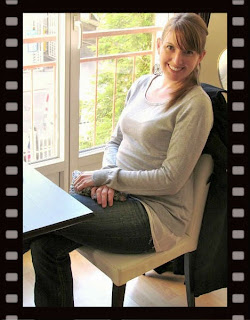My Preemie Story
I was clueless with my first pregnancy despite having read numerous pregnancy books. Living in France, a nation full of hypochondriacs, I didn't take my sage-femme (midwife) seriously when, at 6 months, she informed me my baby's head was down in the birthing position and that I needed to take it easy or risk a premature birth. I chalked it up to a nation of slackers who were looking for an excuse to take it easy. I couldn't have been more wrong (and judgmental, sheesh)!At 35 weeks and 2 days, my water broke as I was getting ready for work. Well, actually, I wasn't 100% sure my water broke but my husband insisted we swing by the hospital to get it checked out. I ended up being admitted to Labor and Delivery and had my baby 18 long hours later. For someone that wanted to come early, my baby sure managed to take his time coming out.
Leonardo was born on 8/8/2012 at 7.5 lbs. Huge for a preemie!

He spent 11 days in the NICU, for the following reasons:
- Respiratory issues, requiring a breathing tube for two days. Now, at 20 months old, he still has asthma but it's mild and manageable with just one treatment per day.
- Jaundice, which is common among preemies and is easily treatable by donning a Batman eye mask and being exposed to a special light for two days.
- Ironically, not gaining enough weight. He was so chubby he got tired quickly when eating and had to resort to a feeding tube to finish his meals. We couldn't leave the hospital until he could eat full meals for two days straight without the feeding tube.
- To err on the side of caution, our hospital preferred to not let a baby out of the NICU until they reach what would have been 37 gestational weeks (to take them officially out of the premature zone).
Looking back, those 11 days were nothing. We were very lucky, especially compared to some of the other families we met during Leo's hospital stay. But no matter what your situation, it's important to YOU and it feels like the biggest deal of your life.
Focus on the Lighter Side
My best remedy is comedy. If you can't see the lighter side, it quickly becomes too heavy. Here's an excerpt from my book, Confessions of a Paris Potty Trainer, where I talk about seeing my son for the first time in the NICU:Thirty Quarter Pounders. 3,750 M&M's. $150 in quarters. What do these have in common (besides the fact that I want them all right now)?
They weigh 7.5 pounds, same as my six-week premature baby.
Preemies come in many sizes, but they're usually not that big. In fact, only 40% of all babies born weigh 7.5 lbs or more. So when we went to see Leonardo Quentin Lesage for the first time in the NICU, Mika and I were shocked.
Surrounded by miniature babies hooked up to respirators and feeding tubes, my ginormous baby looked out of place. Though he was still hooked up to respirators and feeding tubes. Since he was born early, his lungs needed just a little help getting enough oxygen. And since he was born huge, the poor guy wore himself out every time he ate, making it hard to get enough food to sustain his big body. The feeding tube ensured he got his fill in case he fell asleep during a meal.
"We call him The Boss," the nurse said, as she proceeded to explain the machines to us and demonstrate how we could safely hold our son with all those wires attached to him.
"You come into my house on the day my daughter is to be married and you ask me to murder," I said to Mika in my best Marlon Brando.
"I'm gonna make him an offer he can't refuse," Mika countered.
"I am the boss, the Godfather," I said before catching the nurse's eye.
"If you're done, you can hold him now," the nurse said. "And if he wakes up you can try to nurse him." She was nice about it but I could tell she thought we weren't taking the situation seriously.
If I took it seriously, I would probably burst into tears. True, my baby boy was big and relatively healthy, but he was hooked up to an insane number of machines, and I had trouble following her explanations (in French, of course) after 18 hours of labor the previous day and four hours of restless sleep. A few quotes from the Godfather were the only thing keeping me from a full-on breakdown.
Holding my sweet little baby was an amazing feeling. I ran my fingers through his full head of dark hair (still a bit greasy from the delivery, adding to his tough-guy Mafia look) and over his olive skin. Against my pale skin and blond hair, this baby totally didn't look like mine. He looked exactly like his handsome daddy.
Postive Encouragment
I'm currently pregnant with Baby #2, due any day now. At 25 gestational weeks, I went into preterm labor and was subsequently put on bed rest. Scared of repeating what happened with Leo, I took my sage-femme and doctor's advice very seriously and stayed glued to my couch for 11+ weeks. Now that we're past 37 weeks, I'm allowed to walk around, but I'm so out of shape from being immobile for so long! It's been tough but totally worth it. If our baby was born a preemie, we'd be equipped to deal with it. But I wanted to know I'd done everything I could to avoid it.If you currently have a preemie or are in a situation where you suspect you might have one (preterm labor, multiples, high-risk pregnancy) I send you my most positive thoughts and best wishes! And maybe one of these quotes will help get you through the next few days, weeks, or months (feel free to share):
 |  |  |
Are you a parent of a preemie, or know someone who is? Share your story in the comments!

































 What makes me an expert? Well, I'm not an expert but I do get lots of compliments on my cover. But perhaps the biggest compliment of all was winning a gold star in
What makes me an expert? Well, I'm not an expert but I do get lots of compliments on my cover. But perhaps the biggest compliment of all was winning a gold star in